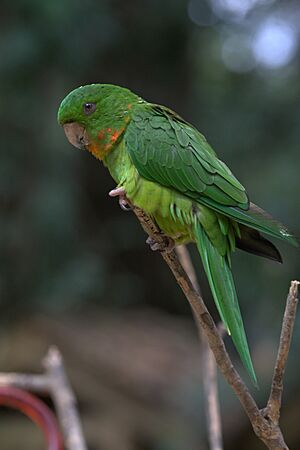Red-throated parakeet facts for kids
Quick facts for kids Red-throated parakeet |
|
|---|---|
 |
|
| At a nature reserve near Copan, Honduras | |
| Conservation status | |
| Scientific classification | |
| Genus: |
Psittacara
|
| Species: |
rubritorquis
|
| Synonyms | |
|
Psittacara holochlorus rubritorquis |
|
The red-throated parakeet (Psittacara rubritorquis) is a colorful bird found in Central America. It's also known as the red-throated conure. These lively birds live in countries like El Salvador, Guatemala, Honduras, and Nicaragua. They are a type of parrot, known for their bright green feathers and a special patch of orange-red on their throat.
Contents
What's in a Name?
How Scientists Name Birds
Scientists give every animal a special name. The red-throated parakeet was first called Conurus rubritoquis. Later, it was moved to a group called Aratinga. Since about 2013, it has been in its current group, Psittacara.
Different Ideas About This Bird
Not all scientists agree on everything. Some groups, like the International Ornithological Committee, think the red-throated parakeet is its own unique species. This means it's a distinct type of bird. Other groups, like the American Ornithological Society, believe it's a subspecies. This means they see it as a special kind of green parakeet.
What Does It Look Like?
The red-throated parakeet is about 28 centimeters (11 inches) long. Both male and female birds look very similar. They are mostly green, but their belly is a lighter, more yellowish green.
Special Markings
The most special part is their throat and upper chest. This area has different amounts of orange-red color. The feathers under their wings are yellowish green. The underside of their flight feathers and tail are olive-yellow.
Eyes, Beak, and Feet
Their eyes are orange-red. Around their eyes, they have bare, pale beige skin. Their beak is a horn color, which is a light brownish-yellow. Their legs and feet are brownish. Young parakeets look similar to adults, but many of them have little or no red on their throats.
Where Do They Live?
The red-throated parakeet lives in Central America. You can find them from eastern Guatemala, south through Honduras and El Salvador, and into northern Nicaragua.
Their Favorite Homes
These birds live in several types of forests. They especially like pine forests in the highlands, which are high up in the mountains. You might even spot them in cities and towns! They usually live at elevations between 800 and 2,600 meters (about 2,600 to 8,500 feet) above sea level.
How Do They Behave?
Moving Around
Some red-throated parakeets move from the high mountains to lower areas when they are not breeding. This helps them find food or better places to live.
What Do They Eat?
Red-throated parakeets often fly in large groups. These groups can have up to 100 birds! While we don't know everything they eat, we do know they enjoy seeds and fruits.
Reproduction and Family Life
We don't know exactly when the red-throated parakeet's breeding season is. It seems to change depending on where they live. They build their nests inside holes in trees. A female parakeet usually lays four eggs. Scientists are still learning about how long the eggs take to hatch and when the young birds leave the nest. We also don't know many details about how the parents care for their babies.
What Do They Sound Like?
The calls of the red-throated parakeet are similar to another bird called the Pacific parakeet. However, their calls are higher pitched. When they are flying, their call sounds like "kreh!-kreh!-kreh!-kreh!...". When they are sitting on a branch, their call is lower pitched, sounding like a "scratchy kreeh-kreeh-kreeh-kreei-kreei".
Are They Safe?
The IUCN (International Union for Conservation of Nature) has looked at the red-throated parakeet. They have decided that this bird is of "Least Concern." This means that it is not currently in danger of disappearing.
Why Are They Safe?
The red-throated parakeet lives in a fairly large area. Even though we don't know the exact number of birds, scientists believe their population is stable. This means the number of birds is not going down. Right now, there are no big threats that could harm them.



